Are your emails getting lost in the spam folder instead of reaching your recipients’ inboxes? As someone who understands the importance of effective email communication, I know the frustration of dealing with spam filters.
In today’s digital age, ensuring your emails are delivered successfully is crucial for business success. In this article, I’ll share valuable insights on how to navigate spam filters and enhance your email deliverability.
By implementing practical strategies and best practices, you can increase the chances of your emails landing where they belong right in front of your audience. Stay tuned to discover actionable tips that will help you bypass those pesky spam filters and optimize your email campaigns for maximum impact.
Understanding Email Deliverability
Email deliverability is essential for successful campaigns, ensuring that emails reach recipients’ inboxes instead of being marked as spam. To improve deliverability, I focus on factors such as sender reputation, engaging content, and monitoring key engagement metrics.
Maintaining a good sender reputation by sending relevant content, crafting spam-free emails, and tracking open rates and click-through rates helps ensure my emails reach their intended audience. By refining these strategies, I can optimize deliverability and enhance the effectiveness of my email marketing efforts.
Common Factors Contributing to Spam Filtering
Email deliverability relies on various factors, and understanding the elements that contribute to emails being marked as spam is crucial to improving deliverability.
Content-related Factors
When it comes to email content, certain elements can trigger spam filters, leading to your emails being diverted from the inbox. It’s vital to avoid using spammy language, excessive punctuation, or misleading subject lines.
Additionally, including too many images or attachments in your emails can raise red flags for spam filters. By crafting relevant, concise, and engaging content, you can significantly reduce the chances of your emails being filtered as spam.
Sender Reputation Factors
- Positive Sender Reputation: Maintain a good reputation by sending valuable content to engaged subscribers, avoiding spam complaints, and monitoring bounce rates.
- Improved Email Deliverability: Focus on proper authentication (e.g., SPF, DKIM) and user engagement to enhance inbox placement and increase the chances of your emails being delivered.
Best Practices to Avoid Spam Filters
Crafting engaging and relevant content is essential to avoid spam filters and improve email deliverability. By creating emails that resonate with recipients, you increase the chances of your messages landing in the inbox rather than being flagged as spam.
Personalizing Email Content
I personalize emails by addressing recipients by their names and tailoring the content to their interests. Personalization creates a connection with the audience, making them more likely to engage with the email and less likely to mark it as spam.
A/B Testing Email Campaigns
A/B testing allows me to experiment with different email elements like subject lines, content structure, and call-to-action buttons. By analyzing the performance of each variant, I optimize my emails for better engagement and higher deliverability rates.
Avoiding Spam Trigger Words
I steer clear of spam trigger words like “free,” “buy now,” and “guarantee,” which can trigger spam filters. By using language that resonates with the audience without raising red flags, I ensure that my emails have a higher chance of reaching the inbox.
Optimizing Email Design for Various Devices
I ensure that my emails are responsive and optimized for different devices, including smartphones, tablets, and desktops. A well-designed email that displays correctly across various platforms enhances user experience and signals to ISPs that the email is legitimate.
Providing Value in Every Email
Every email I send provides value to the recipient, whether through informative content, exclusive promotions, or personalized recommendations. By demonstrating value in every communication, I build trust with subscribers and reduce the likelihood of them marking my emails as spam.
Importance of Authenticating Your Email Domain
Email domain authentication is crucial for ensuring your emails reach recipients’ inboxes and are not flagged as spam. By implementing SPF, DKIM, and DMARC, you validate your identity, enhance deliverability, and protect against email spoofing and phishing attacks.
SPF authorizes mail servers to send emails on your behalf, while DKIM adds a digital signature to verify your message’s integrity. DMARC provides an extra layer of security by instructing how to handle unauthenticated emails and allowing you to monitor your email practices for better performance.

 Lloyd Stafford has been instrumental in the development of Squad Digital Hack, leveraging his extensive knowledge of digital marketing to enhance the platform's offerings. His commitment to delivering practical insights and innovative strategies has helped users navigate the complexities of online marketing. Lloyd’s expertise in social media tactics and email marketing solutions empowers marketers and entrepreneurs to build strong brand visibility and drive meaningful engagement with their audiences.
Lloyd Stafford has been instrumental in the development of Squad Digital Hack, leveraging his extensive knowledge of digital marketing to enhance the platform's offerings. His commitment to delivering practical insights and innovative strategies has helped users navigate the complexities of online marketing. Lloyd’s expertise in social media tactics and email marketing solutions empowers marketers and entrepreneurs to build strong brand visibility and drive meaningful engagement with their audiences.